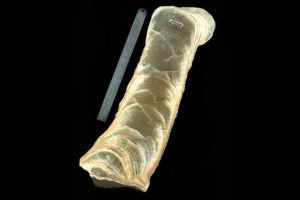
Researchers at the University of Minnesota have found that major flooding and large amounts of precipitation occur on 500-year cycles in central China. These findings shed light on the forecasting of future floods and improve understanding of climate change over time and the potential mechanism of strong precipitation in monsoon regions.
The research is published in the published in the Proceedings of the U.S. National Academy of Sciences (PNAS).
“To predict how climate change will impact the future, it’s important to know what has happened in the past,” said Joshua Feinberg, a University of Minnesota associate professor of Earth Sciences and associate director of the Institute for Rock Magnetism, who supervised the research.
“As the variability and intensity of storms increase in the world, we need to reevaluate what the frequency of these major storms could be,” Feinberg said. “We didn’t have the potential to develop these kinds of precipitation records for most of the world, until now. These speleothems provide more than 8,000 years of data that led us to identify with strong confidence the presence of a 500-year cycle,” he added
The research used stalagmites collected from Heshang Cave in central China within the Yangtze River drainage. Researchers measured the magnetic properties of layered stalagmites, or columnar mineral deposits formed in caves by the growth of carbonate minerals from dripping groundwater. As they form over time, stalagmites develop annual layers of the mineral calcite, which are broadly similar to the rings of a tree. They also collect iron-rich magnetic materials within these layers, which originated in overlying soil and are transported into the cave during precipitation and flooding events. These iron-rich minerals are far less than the width of human hair in size, but produce a strong magnetic signal that can be easily measured by modern magnetometers.
Feinberg and his team analyzed the magnetic properties of the layered stalagmites and discovered more than 8,000 years of data within the materials. The magnetic data varied in such a way as to trace out a 500-year cycle of storm variation, where wetter intervals showed an increased concentration of magnetic minerals. This correlates well with the cycles of El Niño Southern Oscillation pattern and measured changes in the amount of the energy from the sun. The cycle can be used to anticipate broad precipitation patterns in the future, and provide insight on climate change in the region over time. Feinberg and his team hope to expand this work wherever possible around the globe.
With the help of the Institute for Rock Magnetism (IRM), based at the University of Minnesota, the group was able to measure the magnetic materials within the speleothems to at a higher resolution and sensitivity than previously possible. Many rocks record the direction and strength of the Earth’s magnetic field at the time of their formation. By measuring these magnetizations, researchers are able to show how tectonic plates have moved around the globe through time, as well as how the Earth’s magnetic field has varies over timescales ranging from millions of years to decades. The short-term behavior of the Earth’s magnetic field has important ramifications for satellites and satellite communication.
Reference:
Zongmin Zhu, Joshua M. Feinberg, Shucheng Xie, Mark D. Bourne, Chunju Huang, Chaoyong Hu, Hai Cheng. Holocene ENSO-related cyclic storms recorded by magnetic minerals in speleothems of central China. Proceedings of the National Academy of Sciences, 2017; 201610930 DOI: 10.1073/pnas.1610930114
Note: The above post is reprinted from materials provided by University of Minnesota.










